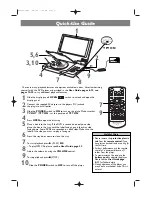
TM-4414 Page 9
Belt/Hydraulic-Drive Generator
SECTION 6
−
TROUBLESHOOTING
6-1. Troubleshooting Table
.
See Section 6-2 for test points and
values and Section 9 and following
for parts location.
.
Use MILLER Testing Booklet (Part
No. 150 853) when servicing this
unit.
.
To avoid charges that are not covered under warranty, troubleshoot and replace components as described. Warranty requests on equipment that
could have been repaired in the field or are misdiagnosed may be denied.
Do not return the generator unless indicated by the troubleshooting guide and factory authorized service agent.
Do not return the control box. Troubleshoot to the circuit board level.
Trouble
Remedy
No generator output at platform AC
receptacles.
Be sure generator control switch is turned on at platform.
Check and secure electrical connections at platform, generator, and control box.
Be sure all equipment is turned off when starting unit.
Reset circuit breaker CB1 (see Section 4-2).
Check plug PLG3 connection and/or connections at receptacles RC3 and RC5.
Be sure +12 volts DC input voltage is being supplied to control box.
Check slip rings, wiring to brushes, and brush position on slip rings. Install new brushes if necessary. See
Section 6-8.
Disconnect leads 12 and 13 from brushes, and check continuity across slip rings (nominal reading is 26
ohms). Replace generator if rotor is open.
Disconnect stator weld leads 1, 2, and 3 from circuit breaker CB1, and check continuity between leads.
Replace generator if necessary.
Disconnect plug PLG4 and check continuity between exciter leads 5 and 6. Replace generator if neces-
sary.
Check power board PC1 and connections, and replace if necessary (see Section 6-4).
Check control board PC2 and connections, and replace if necessary (see Section 6-4).
Low generator output at platform AC
receptacles.
Verify generator is running at 3600 rpm (60 Hz) or 3000 rpm (50 Hz).
Check slip rings, wiring to brushes, and brush position on slip rings. Install new brushes if necessary. See
Section 6-8.
Disconnect leads 12 and 13 from brushes, and check continuity across slip rings nominal reading is 26
ohms). Replace generator if rotor is open.
Disconnect stator weld leads 1, 2, and 3 from circuit breaker CB1, and check continuity between leads.
Replace generator if necessary.
Disconnect plug PLG4 and check continuity between exciter leads 5 and 6. Replace generator if neces-
sary.
Check power board PC1 and connections, and replace if necessary (see Section 6-4).
Check control board PC2 and connections, and replace if necessary (see Section 6-4).
High generator output at platform AC
receptacles.
Verify generator is running at 3600 rpm (60 Hz) or 3000 rpm (50 Hz).
Check slip rings, wiring to brushes, and brush position on slip rings. Install new brushes if necessary. See
Section 6-8.
Check power board PC1 and connections, and replace if necessary (see Section 6-4).
Check control board PC2 and connections, and replace if necessary (see Section 6-4).














































